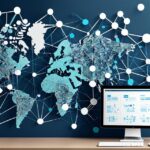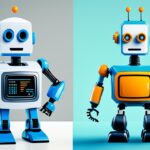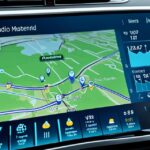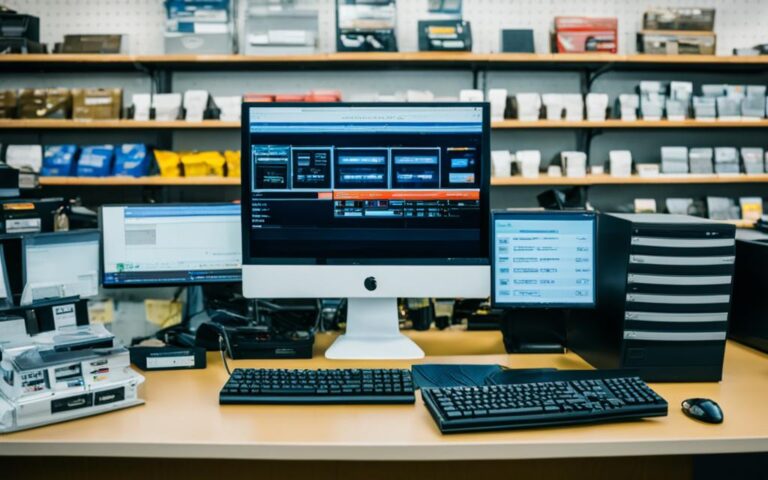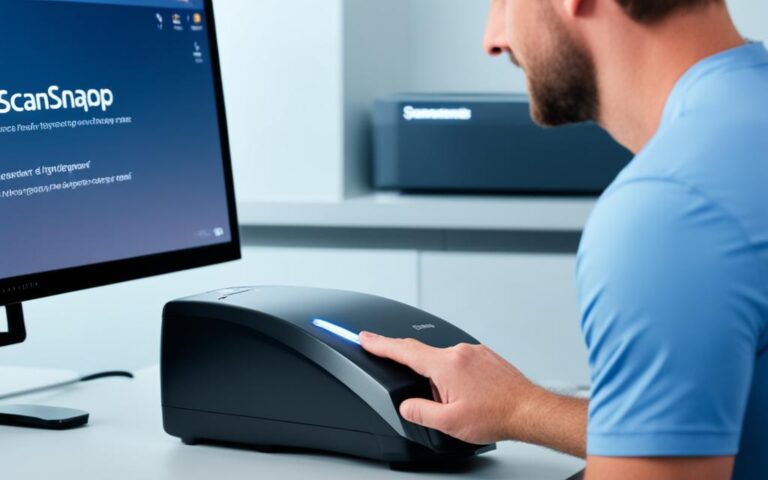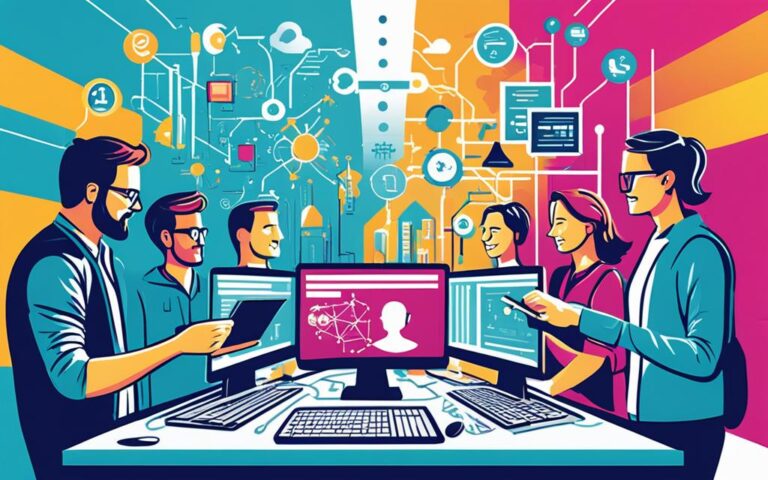Self-replicating programs, or bio-programs, copy themselves over time. They’ve been studied since the early days of computing. John Von Neumann was a key figure in this area. These programs can grow very quickly and bring new power to computing. We’ll look into what self-replicating programs are and how they’re used in different areas.
Key Takeaways
- Understanding self-replicating programs is crucial in today’s digital age.
- The first computer virus outbreak in history was the “Elk Cloner” program created by Richard Skrenta in 19811.
- Frederick Cohen coined the term “virus” in 1983 to explain self-replicating computer programs1.
- Self-replicating programs pose a threat to computer networks and systems.
- In 2010, the Stuxnet worm became the first to attack SCADA systems1.
- SpyEye and Zeus merged in 2011 to target mobile phones for banking information1.
- The Anti-Spyware 2011 Trojan horse disabled internet access for antivirus updates on newer Windows versions1.
- Self-replicating programs infected VAX computers and SUN-3 workstations running 4.2 and 4.3 Berkeley UNIX code2.
- Worms exploited specific network program vulnerabilities and propagated through memory overflow2.
- Contact with infected local networks enabled the spread of worms through guessed passwords2.
- The Morris Worm, released in 1988, quickly infected various machines in a matter of hours3.
- Modern worms like Code Red have demonstrated rapid spread through the internet infrastructure3.
The Origins of Self-Replicating Programs
John Von Neumann, a famous mathematician and computer scientist, started the idea of self-replicating programs. His work on self-reproducing machines was a big step forward in computer science.
Von Neumann’s work was unfinished but had a big impact. It inspired many scientists to look into self-replicating programs.
In the early 1990s, computer viruses became more common, with 15-20 new ones reported every day4. This showed how important it was to protect against viruses.
By 1990, there were about 60,000 computer viruses out there, said McAfee, who made the ViruScan antivirus4. This showed how fast viruses were changing and getting more complex.
Robert Tappan Morris Jr., who made the Internet Worm, was punished in 1988 for his actions4. This showed that making and spreading viruses was a serious crime.
In 1989, a Texas programmer was the first American to be caught for a virus attack4. He had made a logic bomb that deleted 30,000 payroll records. This case showed how dangerous cyber attacks could be.
The Love Bug virus in 2000 spread through emails with the subject “I love you”4. This event made people realize how important it was to protect against email viruses.
These facts4 tell us about the start and growth of self-replicating programs. They highlight the challenges in fighting computer viruses and the need for more research in cybersecurity.
The Computational Efficiency of Self-Replicating Programs
Self-replicating programs are very efficient in how they work. They grow faster than traditional programs5. This means they can solve complex problems quickly. They are great at handling big data, optimizing things, and spotting patterns5.
These programs work like our brains do. Our brains process information fast through many connections. Self-replicating programs copy and spread out to do the same, making them very powerful5. This way, they can solve complex tasks much faster than other methods.
Self-replicating programs can quickly grow and spread. This helps them finish tasks faster than other ways. They are perfect when time is short, dealing with lots of data and doing things at the same time5. They make solving problems quicker in fields like science, finance, and data analysis.
In short, self-replicating programs are great at solving hard problems fast. They use their growth to speed up tasks and give insights in many areas. Their quick growth and handling of big data make them key for complex problems5.
The Philosophy behind Self-Replicating Programs
Self-replicating programs are like the human nervous system in many ways. They work like our brains but can do more because they can copy themselves. This lets them solve complex problems across many areas.
These programs, like Turing Machines, can make copies of themselves. This is similar to how our brains use many paths to process information at once. This makes them very efficient.
They work like our brains by using complex algorithms and making decisions quickly. They can adapt and get better over time, just like our brains do.
They can handle a lot of data, just like our brains do. They take in information and turn it into useful results.
These programs are great at solving tough problems. They can help with things like managing resources or simulating real-world situations. By using their power, we can make big advances in areas like artificial intelligence and robotics.
Types of Cybersecurity Breaches
| Breach Type | Description |
|---|---|
| Breach of Confidentiality | Includes theft of private or confidential information such as credit-card numbers, trade secrets, patents, and financial information6 |
| Breach of Integrity | Involves unauthorized modification of data, manipulating source code to exploit security vulnerabilities6 |
| Breach of Availability | Unauthorized destruction of data, causing chaos or vandalism of websites6 |
| Theft of Service | Unauthorized use of resources like CPU cycles, unauthorized file servers, or tapping into networking services6 |
| Denial of Service (DOS) | Prevents legitimate users from accessing a system by overloading it with a high volume of service requests6 |
| Masquerading | An attack method where the attacker impersonates a trusted third party6 |
| Replay Attack | Involves repeating a valid transmission, sometimes altering the content with malicious information6 |
| Trojan Horse | A program that carries out malicious activities while appearing harmless6 |
| Logic Bomb | Code intended to cause havoc under specific circumstances6 |
| Stack and Buffer Overflow | A classic method exploiting system code bugs leading to potential security breaches6 |
Exploring self-replicating programs shows their huge potential. They can mimic the human brain’s power and solve complex problems. This could change industries and bring together human smarts with tech innovation.
Applications of Self-Replicating Programs
Self-replicating programs are not just fascinating; they have huge potential across many fields. They can change research and innovation in areas like pure mathematics, computer science, and artificial intelligence3. Their impact goes way beyond these areas.
Weather prediction is one area where these programs shine. They can handle huge amounts of weather data to make accurate forecasts. This helps in getting ready for disasters and managing resources3.
Terraforming, or making other planets liveable, also uses these programs. They can simulate complex processes to create conditions for life on other planets. This makes exploring and settling other planets possible3.
In mining, self-replicating programs can find and extract valuable resources on their own. They can adapt and copy themselves, making mining more efficient and less harmful to the environment3.
Exploring space is another area where these programs are useful. They help scientists understand the universe by analyzing data and finding new things. Their power lets us see deeper into space3.
Nanotechnology also benefits from these programs. They help design and make tiny structures. This leads to new materials and devices with special properties3.
In medicine and public health, these programs are very promising. They can look through lots of health data to help find new treatments and prevent diseases. This could change healthcare for the better3.
Cybersecurity is another area where these programs can help. They can find and stop new threats, making digital systems safer. This is crucial in today’s digital world3.
Self-replicating programs are leading the way in technology. They bring huge computing power to many fields, opening up new areas of research and innovation.
Applications of Self-Replicating Programs:
| Field | Applications |
|---|---|
| Pure Mathematics | Advancing mathematical research and analysis |
| Computer Science | Revolutionizing computation and algorithm development |
| Artificial Intelligence | Enhancing machine learning and data analysis |
| Weather Prediction | Improving forecasting accuracy and disaster preparedness |
| Terraforming | Transforming celestial bodies for habitation |
| Mining | Optimizing resource extraction and reducing environmental impact |
| Galactic Exploration | Discovering and understanding the universe |
| Nanotechnology | Designing advanced materials and nanostructures |
| Medicine and Public Health | Advancing personalized healthcare and disease prevention |
| Cybersecurity | Enhancing threat detection and defense systems |
Exploring self-replicating programs shows their huge potential. They can change everything from space exploration to nanotechnology. These programs are key to new discoveries and advancements in science and technology.
Example: Instantiating a lot of variables quickly
Self-replicating programs are great for creating lots of variables fast. They let us instantaneously generate and plot many bio-objects quickly. This means we can make a big number of variables in a little time, which is useful for many areas.
Using self-replicating programs, we can make variables at an exponential rate. This is great for complex tasks like simulations or modeling. It helps us create lots of variables fast, which is key for getting accurate results.
Unlocking the Power of Exponential Growth
Self-replicating programs use the power of exponential growth to create variables fast. They use smart algorithms and coding to make lots of variables quickly. This is because exponential growth is very efficient.
With self-replicating programs, we start a process that makes more variables based on rules or algorithms. Each new variable makes more variables, so the number grows fast. This is what we mean by exponential growth.
The Potential of Bio-Objects
Creating variables quickly with self-replicating programs lets us use bio-objects to their full potential. These can have special features or functions. This means we can do more in fields like data analysis or solving problems.
Applications and Benefits
Being able to make lots of variables fast has many uses. In science, it helps make big datasets for study. This lets researchers look into complex things and find patterns.
In business, it helps with making things better, like testing different scenarios quickly. This is key for making quick, smart decisions in fast-changing situations.
Self-replicating programs are also good for making artificial intelligence systems better. They can create lots of training data. This helps make AI models more accurate and pushes AI forward.
The Future of Bio-Objects
Being able to make many variables quickly with self-replicating programs opens up new doors for innovation. As we keep improving, we’ll see more breakthroughs in many areas. This will drive progress and change the world.
The Nature of Bio-Programs
Bio-programs act like living cells, copying themselves and activating proteins in DNA7. They can make copies of themselves, just like cells do in nature. When they copy, they get new inputs and start to work in a special way7. This is similar to how proteins in DNA get made to do certain jobs.
By looking at bio-objects as a whole, we can control how they change and use global traits to make them work better7. This idea is like genetic algorithms, which use self-copying and evolution. In these algorithms, the best ones get to make more copies, just like in nature.
Bio-programs are very useful and can be used in many areas, like in biology, making new life forms, and understanding complex data7. They can solve hard problems and make things work better because they can copy and change themselves.
Scientists are finding new ways to use bio-programming, which helps us learn more about life and technology7. These discoveries are changing how we see technology and giving us new insights into life itself.
The image above shows how cells reproduce, highlighting the complex beauty of nature’s programming. It reminds us of the strong links between bio-programs and living organisms7.
Bio-programs let us use the power of cell reproduction, protein activation, and genetic algorithms. Through copying and changing, they open new doors in technology and biology.
Electronic Architecture and Bio-Computers
Turing Machines laid the groundwork for traditional computers but weren’t ideal for bio-programs. Yet, traditional computers can still use self-replicating programs to solve many problems. These programs show great efficiency and have helped in scientific research and tech growth.
Folding@home is a prime example of a self-replicating program. By March 2020, it hit 1.22 exaflops, becoming the first exaflop system8. By April 12, 2020, it reached 2.43 exaflops8. Since starting in 2000, it has helped in 226 scientific papers, showing its big impact on computational biology8.
Folding@home has made big strides in protein folding simulations. From 2000 to 2010, it studied four times more proteins, deepening our understanding of biology8. It also sped up protein folding simulations by six times, making them more accurate8.
In 2002, Folding@home used Markov state models to do a million CPU days of simulations in months8. This showed the program’s power in analyzing complex biology. By 2010, it simulated the slow-folding NTL9 protein in 1.52 milliseconds, a huge leap forward8.
Traditional computers have been key in research and breakthroughs. But bio-computers are bringing new possibilities. They’re made for bio-programs and use electronic architecture inspired by nature. This makes them better at processing biological data.
Bio-computers could change fields like medicine and drug discovery by simulating biology faster and more accurately. They bring together electronic architecture and bio-programming for better performance and understanding of biology.
Bio-computers excel at mimicking nature’s parallel processing. This lets them handle big simulations and data analysis better than traditional computers in some areas. Self-replicating programs and bio-computers are opening new doors in science and computational biology.
Advantages of Bio-computers
| Advantages | Description |
|---|---|
| Parallel Processing | Bio-computers use nature’s parallelism for efficient complex data processing. |
| Enhanced Performance | Combining electronic architecture with bio-programming makes bio-computers better than traditional computers in some areas. |
| Deeper Biological Insight | Bio-computers closely mimic nature, offering deeper insights into complex biological processes. |
| Scientific Innovation | Bio-computers drive innovation in fields like medicine, drug discovery, and computational biology. |
Bio-computers are a big step forward in using self-replicating programs for real-world challenges. As researchers explore more in computational biology, the mix of electronic architecture and bio-programming promises new discoveries and big changes in science.
The Power of the Human Nervous System
The human nervous system is a marvel of biology, full of incredible power. It has grown and changed over time, becoming a top tool for solving problems and growing our minds.
Learning about the human nervous system helps us solve complex problems that were once too hard. Its power and ability to grow make it a key area for science and solving problems.
“No amount of computational power in chimpanzee teams, ordinary eight-year-olds, IQ 90 construction workers, or even average mathematics PhDs organized into teams can match the groundbreaking intelligence of the human nervous system.”9
Teams have many benefits, like working together on tasks like writing and keeping records. They use technology for quick calculations and make decisions together. But, they also have their limits.
“While teams excel in many areas, they often struggle to simulate the creative problem-solving abilities associated with individual intelligence, resulting in a bottleneck for new inventions and discoveries.”9
Teams need smart people to work well at every level. They can be slow because of coordination issues and may face conflicts when making decisions.
By using the power of the human nervous system, we can beat these challenges. Understanding the brain better lets us use self-replicating programs to change how we solve hard problems.
The Importance of Self-Reproducing Machines
Self-reproducing machines, or quines, are key in the world of self-replicating programs. They can make their own source code, showing the power of self-replication. Thanks to Klein’s recursion theorem10, quines can be made in any Turing-complete language. This makes them a big deal for programmers and fans.
Quines are vital in programming and have many uses. They let programmers play and learn about self-replication. People use quines for fun and as a challenge10. They also help teach complex ideas like recursion and programming language mechanics10.
“Self-reproducing machines highlight the fascinating and intricate side of programming, pushing the boundaries of what software can achieve.”
Self-reproducing machines are more than just fun. They help programmers understand self-replication, which can make bigger programs better10. Learning about them is a step towards grasping complex computer systems.
The Role of Quines in Software Development
In software development, quines boost creativity and new ideas. They push programmers to think differently and innovate10. By challenging the usual ways, developers can come up with fresh solutions.
Quines are also great for testing programming languages and compilers. They help check how well self-reproduction works, letting developers improve their code10.
Expanding Knowledge through Self-Reproducing Machines
Studying self-reproducing machines like quines is interesting and educational. It helps us understand complex systems and recursion theory10. Looking into quines gives us insights into self-replicating programs and their future in AI and machine learning.
Conclusion
Self-replicating programs have become key in computing, giving us huge boosts in efficiency. They let us solve complex problems better and faster than before. By using bio-programs, we can tackle tough challenges more effectively.
These programs have many uses across different areas. They can change fields like math and cybersecurity for the better. They give us more power than old ways of programming, helping us solve big problems in new ways.
But, we must be careful with this power. As we explore self-replicating programs, we need to balance new ideas with ethics. The risk of viruses and worms, like the VBS.SST@mm worm11, shows we must be cautious.
In summary, self-replicating programs are a big step forward in making computers work better and solve problems. They let us go beyond what we could do before, shaping tech’s future11. But, we must be careful and responsible1112.
FAQ
What are self-replicating programs?
Self-replicating programs can copy themselves over time. They grow quickly and bring new power to computing.
Who was John Von Neumann?
John Von Neumann was a key figure in self-replicating programs. He created the first self-replicating computer virus in his research on self-reproducing machines.
What is the computational efficiency of self-replicating programs?
These programs work much faster than traditional ones. They solve problems more efficiently by growing exponentially.
What is the philosophy behind self-replicating programs?
They work like our nervous system, not our brain. This means they can process information much faster and more efficiently.
What are the applications of self-replicating programs?
They’re used in many areas like math, computer science, AI, weather forecasting, and more. They also help in medicine, health, and keeping systems safe online.
Can self-replicating programs be used to instantiate variables quickly?
Yes, they can quickly create many variables. This is useful for solving complex problems fast.
What is the nature of bio-programs?
Bio-programs work like how cells and proteins in our body do. By understanding them, we can control and improve their actions.
Can self-replicating programs be run on traditional computers?
Yes, they can be used on regular computers too. But, a special kind of computer called a bio-computer is being made for them.
What is the power of the human nervous system?
Our nervous system is incredibly powerful because it can replicate cells and proteins. This helps us solve hard problems that were once unsolvable.
What is the importance of self-reproducing machines?
Self-reproducing machines, or quines, are key to understanding self-replicating programs. They can make copies of themselves, showing how programs can reproduce. Quines are useful in programming and fun to use.
What is the significance of self-replicating programs?
These programs offer a new way to solve complex problems. By using self-replication and bio-programs, we can tackle challenges more effectively than before.
Source Links
- https://www.123helpme.com/essay/The-Origin-Of-Computer-Viruses-709551 – The Origin Of Computer Viruses – 1331 Words
- https://datatracker.ietf.org/doc/html/rfc1135 – RFC 1135: Helminthiasis of the Internet
- https://www.ijtrd.com/papers/IJTRD13399.pdf –
- https://home.adelphi.edu/~siegfried/gen110/viruses.html – GEN 110 – Freshman Seminar: Computers and Society
- https://www.oreilly.com/library/view/computer-security-basics/0596006691/ch04.html – Computer Security Basics, 2nd Edition
- https://www.cs.uic.edu/~jbell/CourseNotes/OperatingSystems/15_Security.html – Operating Systems: Security
- https://www.nature.com/articles/s41598-023-34729-0 – PeruNPDB: the Peruvian Natural Products Database for in silico drug screening – Scientific Reports
- https://en.wikipedia.org/wiki/Folding@home – Folding@home
- https://slatestarcodex.com/2015/12/27/things-that-are-not-superintelligences/ – Things That Are Not Superintelligences
- https://oreilly.com/library/view/computer-security-basics/0596006691/ch04.html – Computer Security Basics, 2nd Edition
- https://www.giac.org/paper/gsec/478/vbssstatmm-worm/101093 – What is VBS.SST@mm Worm?
- https://www.docsity.com/en/cis-105-final-exam-actual-exam-2024-2-different-versions-computer-applications/10886836/ – CIS 105 FINAL EXAM ACTUAL EXAM 2024 | 2 DIFFERENT VERSIONS | COMPUTER APPLICATIONS | Exams Information Technology | Docsity


